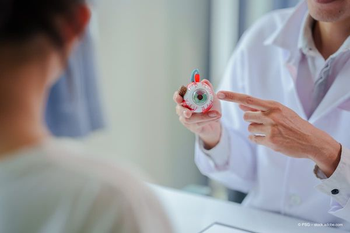
Intraoperative surgical methods hold key to AMD treatment
Researchers find that targeted subretinal delivery of stem cell derived RPE to geographic atrophy is feasible
Targeted subretinal surgery for delivery of a novel biosynthetic retinal pigment epithelial (RPE) monolayer in eyes with advanced dry
Speaking at the 37th annual meeting of the
Dr. Kashani is assistant professor of clinical ophthalmology,
Known as the California Project to Cure Blindness RPE 1 (CPCB-RPE1), the 3.5 mm x 6.25 mm implant is comprised of a human embryonic stem cell-derived RPE monolayer on an ultrathin synthetic parylene substrate.
“With the emergence of cell-based therapies, targeted delivery to specific regions of the retina is increasingly important,” Dr. Kashani said. “We have demonstrated the feasibility of a surgical method that specifically targets the area of geographic atrophy (GA) for RPE replacement.”
Safety first
Dr. Kashani noted that whereas safety is the primary objective of the phase 1/2A study, the researchers are also assessing the potential efficacy of their implant, and they look forward to analyzing the functional outcomes data.
“More broadly, however, by showing that our surgical technique can specifically target the subretinal space that was previously thought to be inaccessible, our experience allows us to think farther ahead about which patients we can successfully treat through subretinal implantation and what other types of therapies we can deliver,” he added.
A total of 16 patients with advanced dry AMD were enrolled in the phase 1/2A study. The first seven cases were done using a standard vitrectomy-enabled operating microscope with 3D binocular viewing system, and the last nine procedures were performed with an intraoperative optical coherence tomography (iOCT) enabled microscope. All surgeries were done at the Outpatient Surgery Center of the University of Southern California, Keck School of Medicine.
Intraoperative OCT-based measurements performed before and after implant placement showed that a significant area of the geographic atrophy could be targeted and covered with the implant. In at least three subjects, the implant covered 100% of the area of GA, and in the last 14 patients, the area of GA coverage was >50%.
Surgical technique
Dr. Kashani noted that previous efforts at delivering stem cell-derived RPE cells or other types of stem cells have involved injection of cell suspensions into the vitreous space or into the subretinal space surrounding the GA region with the aim of providing trophic support to the surrounding viable RPE.
Unlike the technique used for implanting CPCB-RPE1, the earlier methods did not target creation of a space that specifically involved the area of GA and did not reliably result in cell delivery to the disease-affected area.
“With the other approaches, the delivered cells usually do not reach the area of GA because the retina there is very adherent to the underlying Bruch’s membrane and does not detach easily,” said Dr. Kashani.
In order to separate the area of GA from the underlying Bruch’s membrane to create a space that would match the implant’s dimensions and keep it in place, the USC team of ophthalmologists developed a method where they used a 41-gauge subretinal infusion cannula to elevate a bleb immediately outside the region of the GA and then hydrodissected the retina overlying the area of GA using a curved subretinal infusion cannula.
“This required fairly delicate maneuvers, but it was very doable,” Dr. Kashani said. “We found that with our technique, the area of detachment reproducibly included only the GA region and about one-disc-diameter around its periphery, which was our goal. Other methods that have been used for subretinal injections with only a 41-gauge tip result in a bleb that tends to migrate unpredictably.”
To prepare the retinotomy site for implant delivery, the subretinal injection site was enlarged to about 1 mm using a vertical scissor. Then, the implant was loaded into and delivered with a custom-designed and manufactured surgical insertion forceps.
Perfluorocarbon (PFC) heavy liquid was injected to flatten the retina overlying the implant, air-fluid exchange was performed, the PFC was completely removed, and expansile gas or silicone oil was instilled for tamponade.
Intraoperative OCT (iOCT) adds value
Dr. Kashani reported that iOCT guidance facilitated the procedure and helped improve efficiency of the surgical steps.
“We were able to do the first several cases without iOCT, but the subsequent cases were enhanced by iOCT because it provided high-resolution visualization of the subretinal space and implant,” he explained. “For example, iOCT was helpful for allowing us to see where the retina was detaching, localizing subretinal adhesions and for guiding accurate implant placement."
As a result, its use improved our surgical efficiency, Dr. Kashani noted.
“As we gained experience and refined our techniques, we were able to complete the surgery in about 2 hours, indicating that it should be feasible to do the implantation as an outpatient procedure,” he concluded
Disclosures:
Dr. Kashani is principal investigator of the clinical trial funded by Regenerative Patch Technologies through the University of Southern California. Dr. Kashani receives honoraria, grant support and speaking fees from Carl Zeiss Meditec.
Newsletter
Keep your retina practice on the forefront—subscribe for expert analysis and emerging trends in retinal disease management.










































